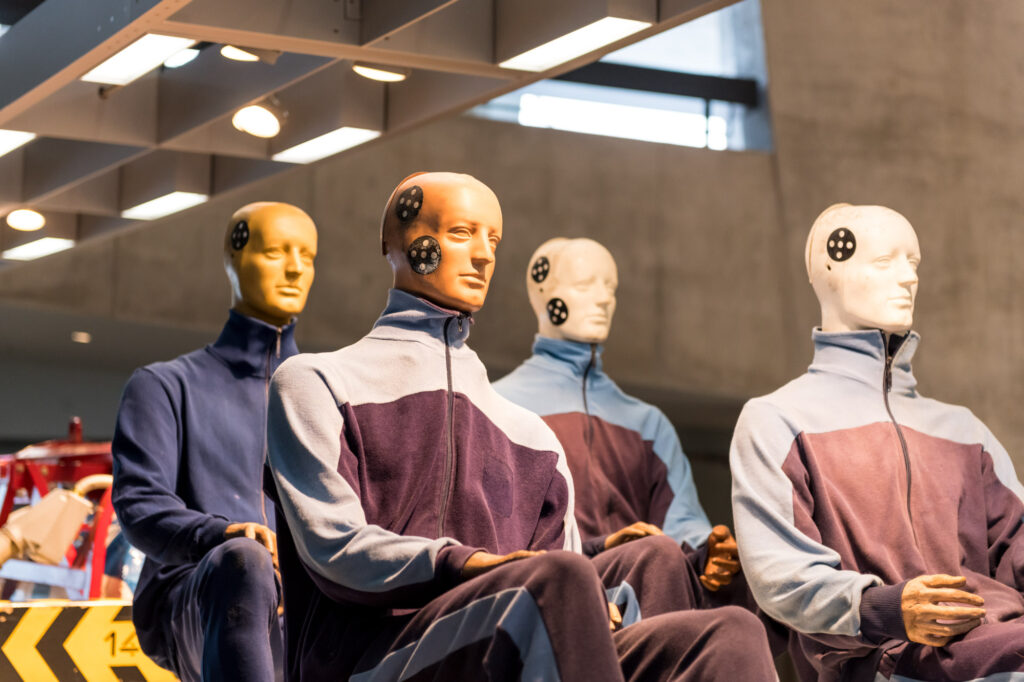Airbags, seatbelts, and door locks are just some of the standard safety features in vehicles today. They keep us safe on the road and have saved countless lives.
These mechanisms were developed with the help of crash test dummies–human-like, anthropomorphic test devices that simulate the dimensions, weight proportions, and articulation of the human body.
When Were Crash Test Dummies First Used?
Crash test dummies were first used in 1949 for flight testing. The first model, called the Sierra Sam, was developed by the Sierra Engineering Co. as part of a contract with the US Air Force.
Around the time the Sierra Sam was developed, they were testing pilot restraint and ejection systems for airplanes.
The Crash Test Pioneer
Colonel John Paul Stapp, an Air Force flight surgeon in the 50s, noticed fighter pilots were perishing more in car crashes rather than plane issues.
This prompted Stapp to begin a crash test study program, which included putting dummies into salvage cars and crashing them into wood or concrete barriers.
With the help of some human volunteers, Stapp took the data from the tests to recommend different safety features we still use today. These include safety locks, better bumper design, and padded dashboards to absorb energy.
Sapp shared the results of his first crash-test research in 1956 at an annual conference which included auto manufacturers.
How Crash Test Dummies Evolved

Before anthropomorphic test devices were developed, crash tests were conducted with human volunteers. They also used cadavers and animals, such as chimpanzees and hogs. Rising safety standards and higher speed tests led researchers to develop safer alternatives.
Hybrid I
In 1966, Alderson Research Laboratories made the VIP-50 series, the first dummy specifically designed for automobile testing. While it was produced for General Motors (GM) and Ford, the National Bureau of Standards also used this dummy.
Fast forward a year later, Sierra Engineering introduced the Sierra Stan to compete with the VIP-50. GM wasn’t satisfied with both, so they had their engineers combine the best features of the two prototypes to build the Hybrid I.
The Hybrid I was not only durable, but it was also capable of producing more repeatable results compared to its predecessors.
GM used the model internally but shared the design with competitors at the Society of Automotive Engineers (SAE) committee meetings.
Hybrid II
In the mid-60s, Congress passed the National Traffic and Motor Vehicle Safety Act of 1966. Automotive design and manufacturing became a regulated industry, sparking debates between the government and manufacturers about the credibility of crash test dummies.
As a compromise, GM engineers improved upon the Hybrid I and submitted the designs for the Hybrid II to the government and dummy manufacturers in 1972. This dummy’s size and weight represent the average adult male population in the United States. GM defined the crash test dummy in engineering terms and standardized its performance in a controlled laboratory setting.
It later became the standard for frontal crash testing mandated by the National Highway Traffic Safety Administration (NHTSA) to comply with the US automotive regulations to meet Federal Motor Vehicle Safety Standard No.208.

Hybrid III
While the Hybrid II did a fantastic job testing crashes and countless scenarios, GM wanted a dummy that more accurately reflected the biomechanics of the human body during vehicle crashes.
In 1972, the Hybrid III was conceptualized to develop a third-generation human-like test dummy that could respond closer to biomechanical data. The research included studies on how people sat on vehicles and how their postures differ depending on their eye position.
Hybrid III was 5’9 and 173 lbs., the average size of males in the US at the time. It also featured six high-strength steel ribs that can simulate human chest deflection and a lower torso with a rubber lumbar spine that curves like ours when seated.
Fast forward to 1983, GM asked the NHTSA for permission to use the Hybrid III as an alternative test device for government compliance. They also provided targets for dummy performance during testing, which helped translate the Hybrid III’s data into safety improvements.
By 1991, the International Standards Organization (ISO) acknowledged the Hybrid III as the standard for international frontal impact testing.
THOR
Crash test dummies have been a vital part of collecting data to improve the safety of vehicles. It’s fair to say that the Hybrid III paved the way for inventions like seat belts and airbags.
However, research done by the Government Accountability Office shows that crash test dummies need updating to cater to different groups of people.
This prompted the NHTSA to work on a new model called the Test Device for Human Occupant Restraint, otherwise called “THOR”.
THOR is more sophisticated than its predecessors, as it has better biofidelity and sensing, replicating human movement and gathering detailed information about what happens to our bodies in a crash with the help of sensors.
What Is the Future of Crash Test Dummies?
GM has been constantly tinkering and working on various ways to improve the crash test dummies we have today. This includes potentially having a computer capturing field data from collisions to get crash information that was previously inaccessible. Their researchers are also improving the lower leg design to get better responses and adding skin to the dummy’s neck.
Any information provided on this Website is for informational purposes only and is not intended to replace consultation with a professional mechanic. The accuracy and timeliness of the information may change from the time of publication.


















